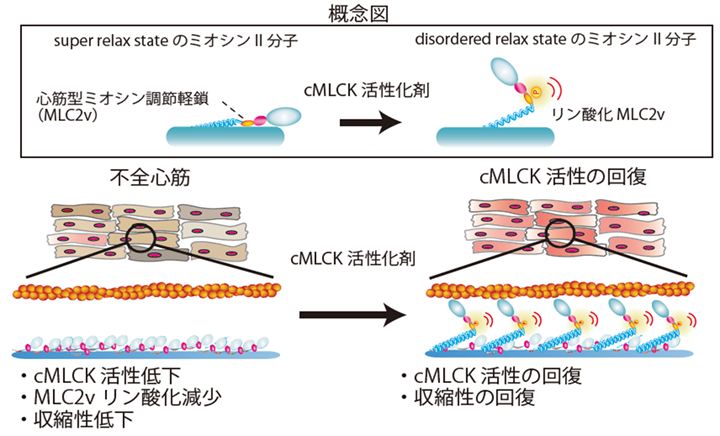Development of novel heart failure drugs targeting organ-specific kinase (cardiac-specific myosin regulatory light chain kinase)
Information updated: July 31, 2023
- Seeds Information
- Researcher Information
- What do you expect from collaboration with companies?
- Contact for this research
Seeds Information
keyword
Dilated cardiomyopathy, cMLCK, heart failure drug, MLC2v
Field
Cardiology
Overview
In this study, we elucidated the mechanism by which human dilated cardiomyopathy develops due to a decrease in the activity of myosin regulatory light chain kinase (cMLCK), which is specifically expressed in cardiac myocytes. Furthermore, we succeeded in developing a small molecule compound that specifically activates cMLCK, and demonstrated that administering this compound to cardiac myocytes with decreased cMLCK activity reactivates cMLCK and restores contractility.
cMLCK is a kinase that is specifically expressed only in cardiac myocytes, and it was already known that it can "physiologically control cardiac contractility" by phosphorylating cardiac myosin regulatory light chain, but its involvement in the pathology of heart failure in humans was unknown. In recent years, several research groups, including ours, have discovered several familial dilated cardiomyopathies with mutations in the MYLK3 gene that encodes cMLCK, and we hope to "elucidate the molecular mechanism by which cMLCK activity affects the pathogenesis of heart failure" and "potentially identify a new therapeutic target molecule."
The effect of improving myocardial contractility by activating cMLCK is expected to make this a new treatment for heart failure that can safely improve hemodynamics while avoiding the serious side effects that were a concern with conventional inotropic drugs.
What's new?
- Clarification of the mechanism by which decreased activity of cMLCK, which is specifically expressed in cardiac myocytes, leads to the development of dilated cardiomyopathy in humans
- Successfully developed a small molecule compound that specifically activates cMLCK
- This small molecule compound was found to reactivate cMLCK in cardiomyocytes with reduced cMLCK activity, restoring contractility.
What are its advantages over other studies?
Aiming to develop safer and more effective heart failure treatments than ever before, we have obtained compounds based on the new drug discovery concept of activating myocardium-specific cMLCK.
Various experimental materials, such as evaluation systems and model animals, are available to advance research into cMLCK.
What problem does it help solve?
Because "cMLCK activators" can improve contractility without changing intracellular calcium concentrations, they have the potential to be a "heart failure treatment drug with a completely new mechanism" that can avoid the side effects of conventional cardiac inotropes and safely restore hemodynamics in patients with severe heart failure.
Possibility of other applications and developments
We believe that this technology can be applied to heart failure not only in humans but also in animals.
We have a variety of compounds against cMLCK, allowing for various developments.
We are also conducting research into the functional analysis of organ-specific enhancers and their application to treatment (collaboration with Osaka University), which may enable the development of safer and more selective gene therapy methods.
Related Patents
―
Related papers
- Hitsumoto T, Tsukamoto O, et al. Restoration of Cardiac Myosin Light Chain Kinase Ameliorates Systolic Dysfunction by Reducing Superrelaxed Myosin. Circulation. 2023;147 doi: 10.1161/CIRCULATIONAHA.122.062885
- Osamu Tsukamoto, Direct Sarcomere Modulators Are Promising New Treatments for Cardiomyopathies. Int. J. Mol. Sci. 2020, 21(1), 226. doi: 10.3390/ijms21010226
- Kamikubo K, Tsukamoto O, et al. Non-Radioactive In Vitro Cardiac Myosin Light Chain Kinase Assays. J Vis Exp. 2020 doi: 10.3791/61168.
- Hodatsu A, Fujino N, Uyama Y, Tsukamoto O, et al. Impact of cardiac myosin light chain kinase gene mutation on development of dilated cardiomyopathy. ESC Heart Fail. 2019;6:406-415. doi: 10.1002/ehf2.12410.
- Tsukamoto O, Kitakaze M. Biochemical and physiological regulation of cardiac myocyte contraction by cardiac-specific myosin light chain kinase. Circ J. 2013;77:2218-25. doi: 10.1253/circj.CJ-13-0627.
Researcher Information
| full name | Osamu Tsukamoto |
|---|---|
| Affiliation | School of Medicine Department of Biochemistry |
| Specialization | Cardiology |
| Collaborative Researcher | - *There are external collaborators (Osaka University: Seiji Takashima, Tatsuo Hitotsumoto, Junichi Haruta) |
| Related links | Course introduction website |
What do you expect from collaboration with companies?
Collaborating with pharmaceutical companies to conduct joint research aimed at developing new drugs for severe heart failure
・Structural development and efficacy evaluation
・Research funds necessary to advance drug discovery research
Contact for this research
兵庫医科大学 大学事務部 研究推進課
E-mail: chizai@hyo-med.ac.jp
Tel: 0798-45-6488

 Research Seeds Collection
Research Seeds Collection
